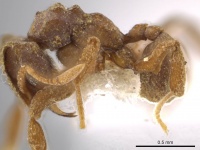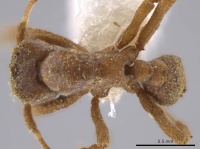Mycetophylax snellingi
| Mycetophylax snellingi | |
|---|---|

| |
| Scientific classification | |
| Kingdom: | Animalia |
| Phylum: | Arthropoda |
| Class: | Insecta |
| Order: | Hymenoptera |
| Family: | Formicidae |
| Subfamily: | Myrmicinae |
| Tribe: | Attini |
| Genus: | Mycetophylax |
| Species: | M. snellingi |
| Binomial name | |
| Mycetophylax snellingi (Mackay, W.P. & Serna, 2010) | |
The type series was collected in a leaf litter extraction from a wet montane habitat.
Identification
Mackay and Serna (2010) - The worker is a small (total length 2 mm) ferrugineous red specimen. The mandibles have seven teeth, the spiniform paraclypeal teeth on the clypeus are markedly well developed; the frontal lobes do not reach the inner borders of the eyes (frontal view of head). The frontovertexal comers form auricle-like structures; the scape is short, and does not reach the posterior margin of the scrobe. The mid pronotal process is angulate, the lateral pronotal tubercles are poorly developed. The anterior mesonotal tubercles are conical and posterior mesonotal tubercles approximately the same size. The propodeum is rounded posteriorly and without angles or spines. The subpetiolar tooth is well-developed and sharp, dorsally the petiole extends over the base of the anterior part of the postpetiole, which has two longitudinal elevated regions, the posterior margin of the postpetiole is nearly straight; the first opisthogastral tergum is without ridges or processes; all femora are swollen ventrally, with carinae, the posterior femur has a well-developed ventral lamina.
Erect hairs are sparse, present on the mandibles, apex of the scape, ventral surfaces of the legs, ventral and posterior surfaces of the gaster; appressed hairs are abundant on the dorsum of the first opisthogastral tergum.
All surfaces dull, except the region along base of mandibular teeth which is smooth and shiny.
Mycetophylax snellingi would key to Mycetophylax faunulus in Kempf's key (1964). It can be easily distinguished as the anterior mesonotal tubercle is relatively small, as compared to the greatly enlarged anterior mesonotal tubercle of M. faunulus. Additionally, the posterodorsal edge of the petiole of M. faunulus does not extend over the anterior face of the petiole as it does in M. snellingi. Mycetophylax faunulus also lacks the erect hairs on the frontal lobes. Although it would key to M. faunulus, the two species do not appear to be morphologically similar.
Distribution
Latitudinal Distribution Pattern
Latitudinal Range: 10.3085492° to 9.8712602°.
| North Temperate |
North Subtropical |
Tropical | South Subtropical |
South Temperate |
- Source: AntMaps
Distribution based on Regional Taxon Lists
Neotropical Region: Costa Rica, Panama (type locality).
Distribution based on AntMaps
Distribution based on AntWeb specimens
Check data from AntWeb
Countries Occupied
| Number of countries occupied by this species based on AntWiki Regional Taxon Lists. In general, fewer countries occupied indicates a narrower range, while more countries indicates a more widespread species. |

|
Estimated Abundance
| Relative abundance based on number of AntMaps records per species (this species within the purple bar). Fewer records (to the left) indicates a less abundant/encountered species while more records (to the right) indicates more abundant/encountered species. |

|
Biology
|
Castes
Nomenclature
The following information is derived from Barry Bolton's Online Catalogue of the Ants of the World.
- snellingi. Cyphomyrmex snellingi Mackay, W.P. & Serna, 2010: 47, figs. 7-12 (w.) PANAMA.
- Combination in Mycetophylax: Sosa-Calvo et al., 2017: 11.
Unless otherwise noted the text for the remainder of this section is reported from the publication that includes the original description.
Description
Worker
HL 0.71-0.74, HW 0.58, SL 0.48-0.50, EL 0.09-0.10, EW 0.08, WL 0.85-0.86. Indices: CI 78-81, SI 64-70, OI 82-86. Mandible with 7 teeth; spiniform paraclypeal teeth very well developed (length 0.07 mm), frontal carinae relatively narrowly spaced, not reaching preocular carina which forms mesiad margin of scrobe; eyes extending past sides of head, with about 20 ommatidia; scrobe greatly extending posteriorly, forming auricle-like structures; scapes not reaching posterior margin of scrobe; tubercles on pronotum poorly developed; anterior and posterior mesonotal tubercles moderately well developed and approximately same size, anterior tubercle with slighter broader base; dorsopropodeum shorter that posteropropodeum, propodeum without spines or angles; subpetiolar tooth sharp and well developed, petiole with two distinct, longitudinal lateral lobes, dorsum of posterior face extending over anterior part of postpetiole; postpetiole with longitudinal depressed region in dorsum of node, outlined by two elongated elevated areas; dorsal surface of gaster flat, bordered laterally by slightly elevated longitudinal areas; all femora with carinae along ventral posterior border, that on posterior femur more developed and forming lamina.
Few erect hairs on mandibles, anteclypeus and frontal lobes, remainder of hairs simple and appressed, located mostly on head and especially gaster.
All surfaces except mandiblular teeth and anterior edge of clypeus dull.
Type Material
Holotype worker (Museum of Comparative Zoology), 1 paratype worker (William and Emma Mackay Collection), Panama, Cerro Campana, 950 m, 5-vi-1995, R. Anderson #17833.
Etymology
Named in honor of the memory of Roy Snelling, recalling a pleasant visit to the Los Angeles County Museum of Natural History in May of 2007 where we spent time with Roy, Gordon Snelling, Brian Brown, and Weiping Xie.
References
- Mackay, W. P. and F. Serna. 2010. Two new species of the strigatus species complex of the ant genus Cyphomyrmex (Hymenoptera: Formicidae) from Costa Rica and Panamá. Journal of Hymenoptera Research. 19:44-50.
- Sosa-Calvo, J., JesÏovnik, A., Vasconcelos, H.L., Bacci, M. Jr., Schultz, T.R. 2017. Rediscovery of the enigmatic fungus-farming ant "Mycetosoritis" asper Mayr (Hymenoptera: Formicidae): Implications for taxonomy, phylogeny, and the evolution of agriculture in ants. PLoS ONE 12: e0176498 (DOI 10.1371/journal.pone.0176498).
References based on Global Ant Biodiversity Informatics
- Longino J. T. L., and M. G. Branstetter. 2018. The truncated bell: an enigmatic but pervasive elevational diversity pattern in Middle American ants. Ecography 41: 1-12.
- Longino J. T., and R. K. Colwell. 2011. Density compensation, species composition, and richness of ants on a neotropical elevational gradient. Ecosphere 2(3): 16pp.
- Longino J. et al. ADMAC project. Accessed on March 24th 2017 at https://sites.google.com/site/admacsite/
- MacKay W. P., and F. Serna. 2010. Two new species of the strigatus species complex of the ant genus Cyphomyrmex (Hymenoptera: Formicidae) from Costa Rica and Panamá. Journal of Hymenoptera Research 19: 44-50.


